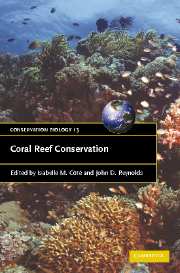Book contents
- Frontmatter
- Contents
- List of contributors
- Foreword
- Preface
- Part I Setting the stage
- 1 Status of coral reefs of the world: summary of threats and remedial action
- 2 Death and resurrection of Caribbean coral reefs: a palaeoecological perspective
- 3 A seascape-level perspective of coral reef ecosystems
- 4 Cold-water coral reefs: status and conservation
- Part II Uses and abuses: ecological and socio-economic issues
- Part III The way forward: tools and approache
- Index
- Plate section
- References
4 - Cold-water coral reefs: status and conservation
Published online by Cambridge University Press: 05 June 2012
- Frontmatter
- Contents
- List of contributors
- Foreword
- Preface
- Part I Setting the stage
- 1 Status of coral reefs of the world: summary of threats and remedial action
- 2 Death and resurrection of Caribbean coral reefs: a palaeoecological perspective
- 3 A seascape-level perspective of coral reef ecosystems
- 4 Cold-water coral reefs: status and conservation
- Part II Uses and abuses: ecological and socio-economic issues
- Part III The way forward: tools and approache
- Index
- Plate section
- References
Summary
INTRODUCTION
Although their existence has been known for centuries, the observation and study of cold-water coral habitats in their natural surroundings began only in the last decade. Scientists around the globe gained access to increasingly sophisticated instrumentation, such as manned and remote operated submersibles, to explore deep-water environments. Their findings challenged conventional wisdom; coral reefs are not only confined to shallow and warm tropical and subtropical regions, but there are a variety of coral ecosystems thriving in deep, dark and cold waters around the globe. Some of these cold-water corals construct banks or reefs as complex as those in tropical areas. Analyses have confirmed that some of these living banks and reefs are up to 8600 years old (Mikkelsen et al., 1982; Hovland et al., 2002), and geological records show that cold-water coral reefs have existed for millions of years.
Cold-water corals grow in dark deep waters. They have no light-dependent symbiotic algae in their tissue and must depend on currents to supply particulate and dissolved organic matter and zooplankton. Many of these cold-water corals produce calcium carbonate skeletons that resemble bushes or trees to support colonies of polyps, maximizing their ability to capture their food efficiently. The result is a complex three-dimensional habitat which provides a multitude of microniches for the associated fauna.
It is only recently that an understanding has developed of the complexity of these cold-water coral ecosystems that are largely hidden and ignored because they can only be observed with complex and expensive equipment.
- Type
- Chapter
- Information
- Coral Reef Conservation , pp. 115 - 144Publisher: Cambridge University PressPrint publication year: 2006



